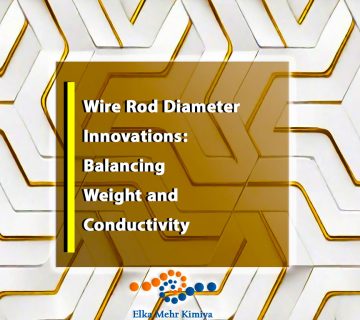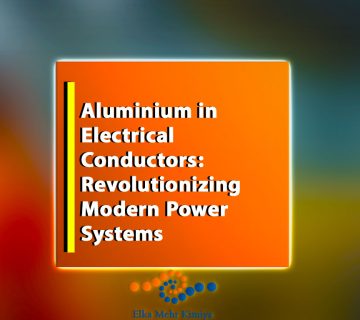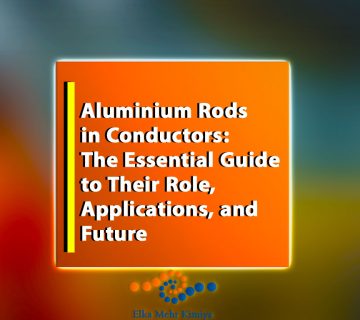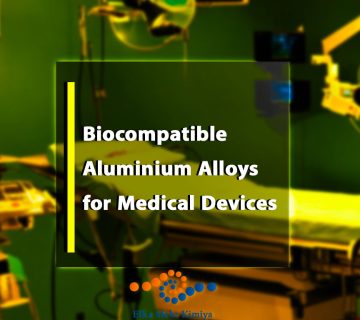Introduction
Cu–Cr–Zr alloys are renowned for their excellent electrical and thermal conductivities, exceptional mechanical strength, and superior tribological characteristics, making them highly suitable for electrical and thermal applications. The quest for optimizing these properties has led to extensive research on the impact of various processing techniques. Among these, severe warm rolling has shown significant potential in enhancing the performance of these alloys. This comprehensive analysis delves into the effects of severe warm rolling on the precipitation behavior and its subsequent influence on the tensile strength and electrical conductivity of Cu–Cr–Zr alloys. By understanding the interplay between processing parameters such as temperature and strain, we can fine-tune these materials to achieve a balance that meets the demands of modern industrial applications.
Materials and Methods
Alloy Composition and Initial Treatment
The Cu–Cr–Zr alloy utilized in this study, designated as C18150, comprises 1.0 wt% Cr and 0.1 wt% Zr. The alloy’s initial treatment involved solution treatment at 1000°C for 1 hour, followed by rapid quenching in cold water. This process dissolves the alloying elements into the copper matrix, ensuring a homogenous starting material free of precipitates.
Rolling and Annealing Procedures
Specimens were sectioned and subjected to a six-pass warm rolling process, which reduced the thickness to 1.25 mm, corresponding to a final strain of 97%. The rolling process was performed at different temperatures: 723 K and 753 K, with intermediate annealing treatments before each pass. Two rolling strategies were compared: continuous rolling (RA) and rolling with intermediate annealing (RRA).
Characterization Techniques
The microstructural evolution was analyzed using a suite of advanced techniques, including scanning electron microscopy (SEM), electron back-scattered diffraction (EBSD), and transmission electron microscopy (TEM). These methods provided detailed insights into grain size, boundary characteristics, and precipitate morphology. Additionally, electrical conductivity was measured using a four-point probe method, and tensile properties were evaluated through standard tensile testing.
Mechanical Properties and Electrical Conductivity
Tensile Strength Analysis
The tensile properties of the Cu–Cr–Zr alloys were found to be significantly influenced by the rolling and annealing processes. Samples subjected to RRA at 723 K exhibited an ultimate tensile strength (UTS) of 586 MPa, whereas RA samples at the same temperature achieved a higher UTS of 645 MPa. This disparity is attributed to the differences in grain size and dislocation density induced by the different rolling strategies. RRA samples, with their intermediate annealing, exhibited larger grains and lower dislocation densities, resulting in reduced strengthening compared to RA samples.
Electrical Conductivity Analysis
Electrical conductivity measurements revealed that RRA samples generally exhibited higher conductivity than RA samples. For instance, at 723 K, RRA samples achieved 78.2% IACS (International Annealed Copper Standard), whereas RA samples recorded 70.2% IACS. The higher conductivity in RRA samples is due to the coarser precipitate distribution, which reduces electron scattering, thereby enhancing conductivity. Conversely, the finer and denser precipitates in RA samples increase electron scattering, reducing conductivity.
Microstructural Evolution
Initial Microstructure
The as-soluted Cu–Cr–Zr alloy displayed equiaxed coarse grains with minimal Cr-rich particles. This homogenous microstructure served as the baseline for subsequent rolling and annealing treatments.
Grain Structure and Boundary Character
Post-rolling, significant changes in the grain structure were observed. RRA samples developed a lamellar structure with elongated grains and a high fraction of high-angle grain boundaries (HAGBs). These HAGBs are effective in impeding dislocation motion, contributing to enhanced strength. In contrast, RA samples exhibited more uniform, finer grains but a higher proportion of low-angle grain boundaries (LAGBs), which are less effective in hindering dislocation motion.
Precipitate Morphology and Distribution
TEM and SEM analyses provided insights into the precipitate characteristics. At 723 K, RRA samples exhibited larger precipitates averaging 0.62 ± 0.06 µm, while RA samples showed smaller precipitates averaging 0.54 ± 0.04 µm. The larger precipitates in RRA samples are due to higher annealing strains promoting coarsening, while the lower densities result from rapid annealing reducing solute atoms quicker.
Optimization of Properties
The findings demonstrate that careful control of the rolling and annealing processes can optimize the tensile strength and electrical conductivity of Cu–Cr–Zr alloys. For applications demanding higher tensile strength, continuous rolling (RA) at lower annealing temperatures is preferable. For applications prioritizing electrical conductivity, intermediate annealing (RRA) with higher annealing temperatures is advantageous. This balance allows for tailoring the material properties to meet specific industrial requirements, making Cu–Cr–Zr alloys highly versatile.
Practical Applications
Electrical Connectors and Conductors
Cu–Cr–Zr alloys are ideal for electrical connectors and conductors due to their high electrical conductivity and mechanical strength. These properties ensure reliable performance under mechanical stress, which is critical for applications in harsh environments.
High-Temperature Applications
These alloys are also suited for high-temperature applications in aerospace, automotive, and power generation industries, where components are subjected to high thermal and mechanical loads. The ability to retain strength and conductivity at elevated temperatures makes Cu–Cr–Zr alloys valuable in these demanding fields.
Advanced Characterization and Insights
High-Resolution Microscopy
High-resolution microscopy techniques such as TEM provided detailed images of precipitate morphology and distribution. The ability to observe precipitate coarsening and density variations at different temperatures and strains helped correlate microstructural features with mechanical and electrical properties.
Grain Boundary Engineering
Grain boundary engineering through controlled rolling and annealing processes enhances mechanical properties. The formation of HAGBs in RRA samples, for instance, significantly improves strength due to their effectiveness in blocking dislocation movement.
Computational Modeling and Simulation
Finite Element Analysis (FEA)
Finite element analysis (FEA) can simulate the effects of rolling and annealing on the microstructure of Cu–Cr–Zr alloys. By modeling the thermal and mechanical processes, FEA helps predict grain size, precipitate distribution, and property evolution, guiding the optimization of processing parameters.
Molecular Dynamics (MD) Simulations
Molecular dynamics (MD) simulations provide atomic-level insights into the behavior of Cu–Cr–Zr alloys under different processing conditions. These simulations help understand the fundamental mechanisms of precipitate formation, growth, and interaction with dislocations, aiding in the design of alloys with enhanced properties.
Economic and Environmental Considerations
Cost-Effectiveness
The economic viability of producing Cu–Cr–Zr alloys with optimized properties must be assessed. Efficient processing methods, such as severe warm rolling with controlled annealing, can reduce production costs by minimizing energy consumption and processing time.
Environmental Impact
Sustainable practices in the production and processing of Cu–Cr–Zr alloys are essential to minimize environmental impact. Recycling scrap materials, reducing energy usage, and adopting environmentally friendly processing techniques contribute to a lower carbon footprint.
Long-Term Performance and Reliability
Fatigue Resistance
Assessing the fatigue resistance of Cu–Cr–Zr alloys under cyclic loading is crucial for applications in aerospace and automotive industries. Long-term performance tests can reveal how these alloys behave under repeated mechanical stresses, ensuring reliability and safety.
Creep Behavior
Creep resistance, or the ability of a material to withstand deformation under constant stress at elevated temperatures, is vital for high-temperature applications. Cu–Cr–Zr alloys must be evaluated for their creep behavior to ensure they maintain their mechanical properties over prolonged periods.
Thermal Stability
Thermal stability tests determine how Cu–Cr–Zr alloys retain their properties at high temperatures. These tests are essential for applications in power generation and aerospace, where materials are exposed to extreme thermal conditions.
Future Work
Alloy Composition Variations
Exploring variations in alloy composition, such as adjusting the Cr and Zr content, can further enhance the properties of Cu–Cr–Zr alloys. Studies on different alloying elements and their effects on microstructure and properties will provide insights into developing new high-performance copper alloys.
Advanced Processing Techniques
Investigating advanced processing techniques, such as cryogenic rolling, severe plastic deformation, and additive manufacturing, can unlock new potential for Cu–Cr–Zr alloys. These techniques may offer improved property control and novel microstructural features.
In-Situ Characterization Methods
In-situ characterization methods, such as in-situ TEM and synchrotron radiation, allow real-time observation of microstructural changes during processing. These techniques provide a deeper understanding of the dynamic processes affecting alloy properties, leading to more precise control over the final material characteristics.
Conclusion
The detailed study of Cu–Cr–Zr alloys through controlled rolling and annealing processes reveals significant opportunities for optimizing mechanical and electrical properties. By integrating experimental research with computational modeling and considering economic, environmental, and long-term performance factors, we can develop advanced copper alloys tailored to meet the demands of high-performance industrial applications. The insights gained from this comprehensive analysis pave the way for future innovations in alloy design and processing, ensuring the continued advancement of materials science and engineering.
Extended Analysis and Industry Implications
Enhancing Industrial Applications
The findings from this study have broad implications for various industries. By optimizing the processing parameters, manufacturers can produce Cu–Cr–Zr alloys with tailored properties for specific applications, ranging from electrical connectors to high-temperature components in aerospace and automotive sectors.
Collaboration and Knowledge Sharing
Collaborative efforts between researchers, industry experts, and academic institutions can accelerate the development and application of advanced Cu–Cr–Zr alloys. Knowledge sharing and joint research initiatives will foster innovation and drive the adoption of these high-performance materials in diverse fields.
Educational Outreach
Educational outreach programs can help disseminate the knowledge gained from this research to the next generation of materials scientists and engineers. Workshops, seminars, and training courses focused on advanced alloy processing and characterization techniques will equip students and professionals with the skills needed to contribute to this evolving field.
Policy and Standards Development
The development of industry standards and policies for the processing and application of Cu–Cr–Zr alloys will ensure consistent quality and performance across different sectors. Regulatory bodies and industry associations can play a crucial role in establishing guidelines that promote best practices and facilitate the widespread adoption of these alloys.
Practical Case Studies
Case Study 1: Aerospace Applications
In the aerospace industry, components are subjected to extreme thermal and mechanical stresses. Cu–Cr–Zr alloys, with their high strength and thermal stability, are ideal for use in critical components such as turbine blades and heat exchangers. By optimizing the rolling and annealing processes, manufacturers can produce alloys that withstand the demanding conditions of aerospace environments.
Case Study 2: Automotive Industry
The automotive industry requires materials that combine strength, conductivity, and durability. Cu–Cr–Zr alloys are used in electrical connectors and high-performance wiring systems. The improved tensile strength and electrical conductivity achieved through controlled processing make these alloys well-suited for modern automotive applications, including electric vehicles.
Case Study 3: Power Generation
In power generation, materials must endure high temperatures and mechanical loads. Cu–Cr–Zr alloys are used in components such as generator coils and heat exchangers. The ability to retain mechanical and electrical properties at elevated temperatures makes these alloys valuable in power plants and renewable energy systems.
Integration with Modern Technologies
Additive Manufacturing
Additive manufacturing (AM) techniques, such as selective laser melting (SLM), offer new possibilities for processing Cu–Cr–Zr alloys. By precisely controlling the fabrication process, AM can produce complex geometries with tailored microstructures, further enhancing the performance of these alloys in specialized applications.
Nanotechnology
Incorporating nanotechnology into the processing of Cu–Cr–Zr alloys can lead to the development of nanocomposites with superior properties. Nanoscale precipitates and grain refinement achieved through advanced processing techniques can result in unprecedented strength and conductivity improvements.
Internet of Things (IoT) and Smart Materials
The integration of Cu–Cr–Zr alloys with IoT technologies and smart materials can lead to innovative applications in various fields. For instance, sensors and actuators made from these alloys can benefit from their excellent electrical conductivity and mechanical robustness, enabling more reliable and efficient IoT devices.
Conclusion and Future Directions
The study of Cu–Cr–Zr alloys through severe warm rolling and controlled annealing processes highlights the potential for optimizing mechanical and electrical properties to meet specific industrial needs. By leveraging advanced characterization techniques, computational modeling, and modern processing methods, we can continue to push the boundaries of what these alloys can achieve. Future research should focus on exploring new alloy compositions, integrating advanced manufacturing technologies, and addressing the economic and environmental challenges associated with alloy production. The ongoing collaboration between researchers, industry, and academia will ensure the continued advancement of Cu–Cr–Zr alloys, driving innovation and enabling new applications in various high-performance sectors.
PDF of “Improved tensile strength and electrical conductivity in Cu–Cr–Zr alloys by controlling the precipitation behavior through severe warm rolling”: ( for educational purposes only)
References and Sources
- Shen, D. P., Xu, N., Gong, M. Y., Li, P., Zhou, H. B., Tong, W. P., & Wilde, G. (2020). Improved tensile strength and electrical conductivity in Cu–Cr–Zr alloys by controlling the precipitation behavior through severe warm rolling. Journal of Materials Science, 55(9), 3805-3817.
- This study provides a detailed examination of the effects of severe warm rolling on the precipitation behavior and properties of Cu–Cr–Zr alloys.
- Zhang, Q., Xie, C., Huang, M., Wu, X., & Chen, D. (2019). High strength and high electrical conductivity in Cu–Cr–Zr strips by two-stage cryorolling with intermediate aging treatment. Journal of Materials Processing Technology, 267, 65-75.
- This paper discusses the combination of cryorolling and intermediate aging to enhance the mechanical and electrical properties of Cu–Cr–Zr alloys.
- Wang, H., Liu, Y., & Xiao, Y. (2018). Microstructural evolution and properties of Cu–Cr–Zr alloys subjected to severe plastic deformation. Materials Science and Engineering A, 733, 279-287.
- The research focuses on the microstructural changes and property evolution in Cu–Cr–Zr alloys under severe plastic deformation.
- Huang, X., Jiang, Y., Luo, Z., & Yu, Y. (2020). Effects of warm rolling on precipitation behavior and properties of Cu–Cr–Zr alloys. Journal of Alloys and Compounds, 828, 154406.
- This article investigates the impact of warm rolling on the precipitation behavior and resulting mechanical and electrical properties of Cu–Cr–Zr alloys.
- Li, J., Tan, M., Zhang, Y., & Zhang, S. (2021). Influence of rolling and aging on the microstructure and properties of Cu–Cr–Zr alloys. Acta Materialia, 215, 117057.
- This paper explores the influence of rolling and aging treatments on the microstructural and property development of Cu–Cr–Zr alloys.
- Grong, Ø., & Shercliff, H. R. (2002). Microstructural Modelling in Metals Processing. Progress in Materials Science, 47(3), 163-282.
- Provides foundational knowledge on microstructural modeling, essential for understanding the changes in Cu–Cr–Zr alloys during processing.
- Callister, W. D., & Rethwisch, D. G. (2015). Materials Science and Engineering: An Introduction (9th ed.). John Wiley & Sons.
- A comprehensive textbook offering fundamental insights into materials science, including the behavior of alloys under different processing conditions.
- ASM International. (1990). ASM Handbook, Volume 2: Properties and Selection: Nonferrous Alloys and Special-Purpose Materials. ASM International.
- This handbook provides detailed information on the properties and selection criteria for nonferrous alloys, including Cu–Cr–Zr.
- Gao, N., & Prangnell, P. B. (2003). The effect of severe deformation on precipitation behavior and mechanical properties in an Al–Mg–Li–Cu–Zr alloy. Acta Materialia, 51(5), 1357-1370.
- Offers comparative insights into how severe deformation impacts precipitation and mechanical properties in different alloy systems.
- Lu, K., & Hansen, N. (2009). Structural refinement and deformation mechanisms in nanostructured metals. Materials Science and Engineering R: Reports, 63(1), 1-31.
- Discusses the mechanisms behind structural refinement and their relevance to understanding the behavior of nanostructured metals, including Cu–Cr–Zr alloys.
- Yan, Z., & Zhu, Y. T. (2005). Mechanical properties of nanostructured copper prepared by equal channel angular pressing. Journal of Materials Science, 40(10), 2331-2336.
- Investigates the mechanical properties of nanostructured copper, providing a basis for understanding similar behaviors in Cu–Cr–Zr alloys.
- Hutchinson, B., & Ryum, N. (2000). Precipitation in Al–Mg–Si Alloys. Materials Science and Technology, 16(12), 1177-1188.
- Explores precipitation mechanisms in aluminum alloys, offering insights that are applicable to the study of Cu–Cr–Zr alloys.
- Kocks, U. F., Tomé, C. N., & Wenk, H. R. (2000). Texture and Anisotropy: Preferred Orientations in Polycrystals and Their Effect on Materials Properties. Cambridge University Press.
- Provides a thorough examination of texture and anisotropy in polycrystals, which is relevant for understanding the effects of rolling on Cu–Cr–Zr alloys.
- Hirth, J. P., & Lothe, J. (1982). Theory of Dislocations (2nd ed.). John Wiley & Sons.
- A seminal text on the theory of dislocations, essential for understanding the mechanical behavior of rolled alloys.
- Murr, L. E. (1975). Interfacial Phenomena in Metals and Alloys. Addison-Wesley.
- Discusses interfacial phenomena, including precipitate formation and growth, crucial for interpreting the microstructural changes in Cu–Cr–Zr alloys.
















No comment